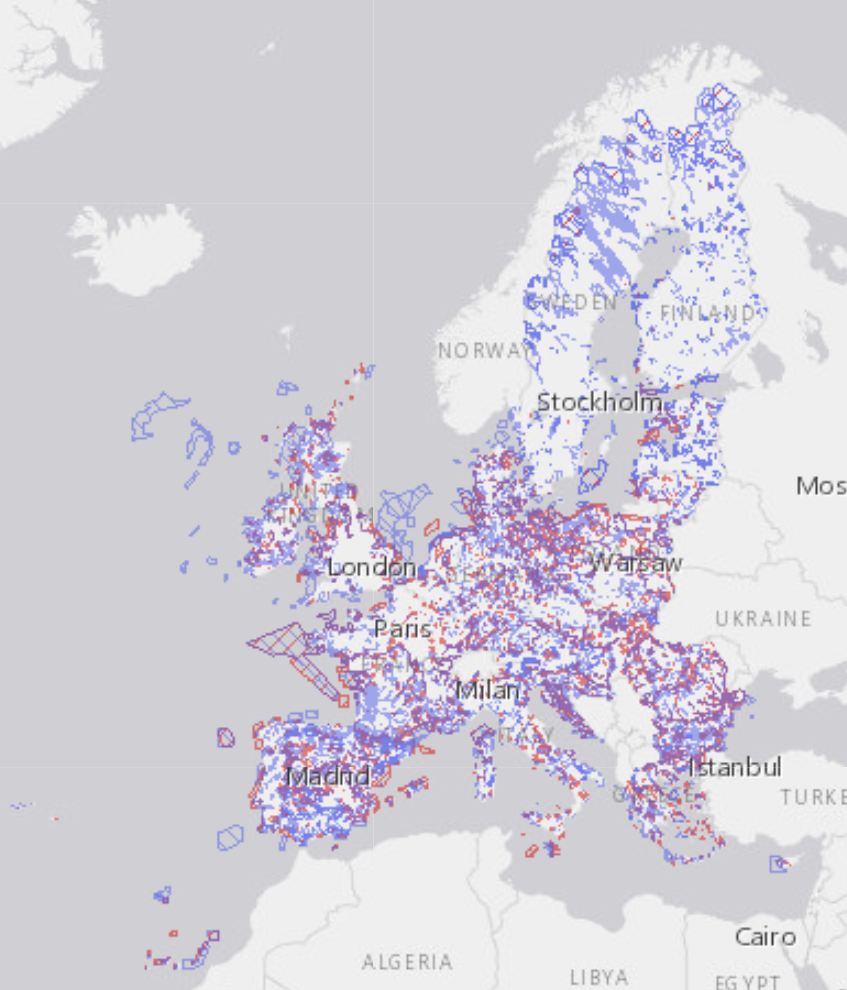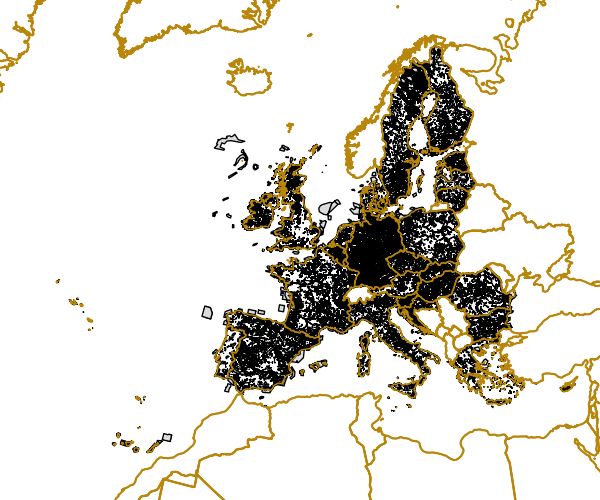Directive 2009/147/EC
Type of resources
Available actions
Topics
INSPIRE themes
Keywords
Contact for the resource
Provided by
Years
Formats
Representation types
Update frequencies
status
Scale
-

Natura 2000 is the key instrument to protect biodiversity in the European Union. It is an ecological network of protected areas, set up to ensure the survival of Europe's most valuable species and habitats. Natura 2000 is based on the 1979 Birds Directive and the 1992 Habitats Directive. This version covers the reporting in 2019. Natura 2000 is an ecological network composed of sites designated under the Birds Directive (Special Protection Areas or SPAs) and the Habitats Directive (Sites of Community Importance or SCIs, and Special Areas of Conservation or SACs). The European database of Natura 2000 sites consists of a compilation of the data submitted by the Member States of the European Union. This European database is generally updated once a year to take into account any updating of national databases by Member States. However, the release of a new EU-wide database does not necessarily mean that a particular national dataset has recently been updated. The descriptive data in the European database are based on the information that national authorities have submitted, for each of the Natura 2000 sites, through a site-specific standard data form (SDF). In addition to other site-specific information, the standard data form provides the list of all species and habitat types for which a site is officially designated. The spatial data (outlining the boundaries of sites) submitted by each Member State are validated by the European Environment Agency (EEA). Any problems identified through the above validation procedures in the national datasets are brought to the attention of the Member States concerned. However, it remains up to the Member States to decide whether to submit a revised dataset before the European database is updated. The EEA therefore cannot guarantee that all inconsistences detected in national datasets are removed in the European dataset. Please note that some Member States have submitted sensitive information that has been filtered out of this database. The following Member States have submitted sensitive information: Austria, Belgium, Cyprus, Estonia, Finland, France, Germany, Ireland, Italy, Latvia, Lithuania, Luxembourg, Malta, Poland, Portugal, Slovakia, Spain, Sweden and United Kingdom. This concerns mainly species associated to specific sites. All reference to these species has been removed from the related sites. If this sensitive information is necessary to your field of research, please contact the Member State administrations individually. You can find a compiled list of national or regional Natura 2000 websites at the following address: http://ec.europa.eu/environment/nature/natura2000/db_gis/index_en.htm#sites There are specific terms and conditions relating to the use of downloaded boundary data within the United Kingdom. If you intend to use the UK data, you must first agree to the end-user licence http://www.jncc.gov.uk/page-5232. Besides the web service link provided in the metadata, the following services provide information on species and habitat types inside the Natura 2000 sites: https://bio.discomap.eea.europa.eu/arcgis/rest/services/ProtectedSites/Natura2000Habitats/MapServer https://bio.discomap.eea.europa.eu/arcgis/rest/services/ProtectedSites/Natura2000Species/MapServer NOTE: The dataset has been corrected in June 2020 and the files uploaded on the SDI on 30 July 2020. Files downloaded before that date has one invalid site type code (G) that was corrected (to B) in June.
-
Short resume in English: Dataset is the areas appointed in accordence whit the directive 2009/147/EC http://inspire.ec.europa.eu/metadata-codelist/PriorityDataset/dir-2009-147 Danish: Udpegningen er implementeret i dansk lovgivning ved s Bekendtgørelse nr. 408 af 1. maj 2007 om udpegning og administration af internationale naturbeskyttelsesområder samt beskyttelse af visse arter med senere ændringer. Et EF-fuglebeskyttelsesområde er ét af tre slags internationale naturbeskyttelsesområder: EF-fuglebeskyttelsesområder, EF-habitatområder samt Ramsarområder. De to førstnævnte betegnes samlet Natura 2000 områder. Levestederne for mange fuglearter forringes eller er direkte truede. Fuglebeskyttelsesområder er med til at opretholde og sikre levestederne. I Danmark er områderne især vigtige for mange vandfugle. Hvert område er udpeget for at beskytte bestemte fuglearter. Grundlaget for områderne er fuglebeskyttelsesdirektivet fra 1979, der har som formål at beskytte og forbedre vilkårene for de vilde fuglearter i EU. Det sker bl.a. ved, at medlemslandene opretter fuglebeskyttelsesområder. Direktivet indeholder også bestemmelser om, hvilke fuglearter der må jages og hvilke jagtmetoder, der må bruges.
-

Gridded Distribution of Species as reported during the Article 12 of the Birds Directive (2009/147/EC) covering the period 2008 to 2012. The data covers the EU 27 (2007). The dataset contains a support version of tabular data as reported by Member States, targeted for the assessment of bird population status at the European level for the 2008-2012 reporting period. This includes population sizes and trends (short and long term) for breeding and wintering populations, as well as pressures and threats for Special Protection Area trigger species. This version includes species flagged as sensitive by Member States. Information on the data quality of the 2008-2012 reporting round is available at http://bd.eionet.europa.eu/article12.
-

Gridded Distribution of Species as reported during the Article 12 of the Birds Directive (2009/147/EC) covering the period 2008 to 2012. The data covers the EU 27(2007-2013, prior to the accession of Croatia to the EU), including the delayed data delivery from Greece. The dataset contains a support version of tabular data as reported by Member States, targeted for the assessment of bird population status at the European level for the 2008-2012 reporting period. This includes population sizes and trends (short and long term) for breeding and wintering populations, as well as pressures and threats for Special Protection Area trigger species. This metadata refers to the public dataset, without sensitive species. NOTE: The spatial dataset has been revised in 2021 as some errores had been found in the original Shapefile. The revision includes also delayed deliveries (Greece).
-

Natura 2000 is an ecological network composed of sites designated under the Birds Directive (Special Protection Areas, SPAs) and the Habitats Directive (Sites of Community Importance, SCIs, and Special Areas of Conservation, SACs). The European database on Natura 2000 sites consists of a compilation of the data submitted by Member States to the European Commission. This European database is generally updated once per year, so as to take into account any updating of the content of the national databases by Member States. However, the release of a new EU-wide database does not necessarily entail that a particular national dataset has recently been updated. The descriptive data in the European database are based on the information that national authorities have submitted, for each of the Natura 2000 sites, through a site-specific standard data form (SDF). Amongst other site-specific information, the standard data form provides the list of all species and habitat types for which a site is officially designated. The spatial data (borders of sites) submitted by each Member State are validated by the European Environment Agency (EEA), including as regard their consistency with the descriptive data. Any problems identified through the above validation procedures in the national datasets are brought to the attention of the Member States concerned. However, it remains up to the Member States to decide whether or not to submit a revised dataset before the European database is updated. As a consequence, the EEA cannot guarantee that all inconsistences detected in national datasets are removed in the European dataset. Please note that some Member States have submitted sensitive information that has been filtered out of this database. The following Member States have submitted sensitive information: Austria, Finland, France, Germany, Ireland, Italy, Latvia, Luxembourg, Poland, Spain and Sweden. This concerns mainly species associated to specific sites. All reference to these species has been removed from the related sites. If this sensitive information is necessary to your field of research, please contact the Member States' administrations individually. You can find a compiled list of national or regional Natura 2000 websites at the following address: http://ec.europa.eu/environment/nature/natura2000/db_gis/index_en.htm#sites There are specific terms and conditions relating to the use of downloaded boundary data within the United Kingdom. If you intend to use the UK data you must first agree to the end user licence http://www.jncc.gov.uk/page-5232. Besides the web service link provided in the metadata, the following services provide information on species and habitat types inside the Natura 2000 sites: https://bio.discomap.eea.europa.eu/arcgis/rest/services/ProtectedSites/Natura2000Habitats/MapServer https://bio.discomap.eea.europa.eu/arcgis/rest/services/ProtectedSites/Natura2000Species/MapServer
-

All EU Member States are requested to monitor birds listed in the Birds Directive (2009/147/EC) and send a report about the progress made with the implementation of the Directive every 6 years following an agreed format. The assessment of breeding population short-term trend at the level of country is here presented. The spatial dataset contains gridded birds distribution data (10 km grid cells) as reported by EU Member States for the 2013-2018 period. The dataset is aggregated by species code and country in the attribute CO_MS. By use of the aggregated attribute [CO_MS], the tabular data can be joined to the spatial data to obtain e.g. the EU population status and trend. This metadata refers to the INTERNAL dataset as it includes species flagged as sensitive by Member States. Therefore, its access is restricted to only internal use by EEA.
 RUC Geo-Data catalogue
RUC Geo-Data catalogue